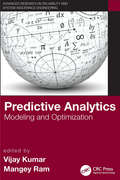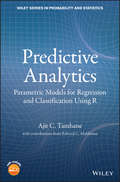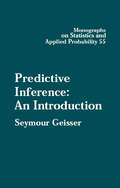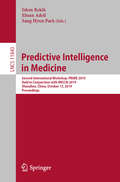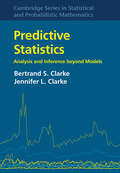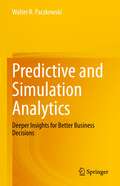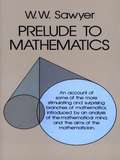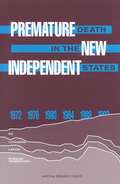- Table View
- List View
Predictive Analytics: Modeling and Optimization (Advanced Research in Reliability and System Assurance Engineering)
by Edited by Vijay Kumar and Mangey RamPredictive analytics refers to making predictions about the future based on different parameters which are historical data, machine learning, and artificial intelligence. This book provides the most recent advances in the field along with case studies and real-world examples. It discusses predictive modeling and analytics in reliability engineering and introduces current achievements and applications of artificial intelligence, data mining, and other techniques in supply chain management. It covers applications to reliability engineering practice, presents numerous examples to illustrate the theoretical results, and considers and analyses case studies and real-word examples. The book is written for researchers and practitioners in the field of system reliability, quality, supply chain management, and logistics management. Students taking courses in these areas will also find this book of interest.
Predictive Analytics: Parametric Models for Regression and Classification Using R (Wiley Series in Probability and Statistics)
by Ajit C. TamhaneProvides a foundation in classical parametric methods of regression and classification essential for pursuing advanced topics in predictive analytics and statistical learning This book covers a broad range of topics in parametric regression and classification including multiple regression, logistic regression (binary and multinomial), discriminant analysis, Bayesian classification, generalized linear models and Cox regression for survival data. The book also gives brief introductions to some modern computer-intensive methods such as classification and regression trees (CART), neural networks and support vector machines. The book is organized so that it can be used by both advanced undergraduate or masters students with applied interests and by doctoral students who also want to learn the underlying theory. This is done by devoting the main body of the text of each chapter with basic statistical methodology illustrated by real data examples. Derivations, proofs and extensions are relegated to the Technical Notes section of each chapter, Exercises are also divided into theoretical and applied. Answers to selected exercises are provided. A solution manual is available to instructors who adopt the text. Data sets of moderate to large sizes are used in examples and exercises. They come from a variety of disciplines including business (finance, marketing and sales), economics, education, engineering and sciences (biological, health, physical and social). All data sets are available at the book’s web site. Open source software R is used for all data analyses. R codes and outputs are provided for most examples. R codes are also available at the book’s web site. Predictive Analytics: Parametric Models for Regression and Classification Using R is ideal for a one-semester upper-level undergraduate and/or beginning level graduate course in regression for students in business, economics, finance, marketing, engineering, and computer science. It is also an excellent resource for practitioners in these fields.
Predictive Control: for Linear and Hybrid Systems
by Francesco Borrelli Alberto Bemporad Manfred MorariModel Predictive Control (MPC), the dominant advanced control approach in industry over the past twenty-five years, is presented comprehensively in this unique book. With a simple, unified approach, and with attention to real-time implementation, it covers predictive control theory including the stability, feasibility, and robustness of MPC controllers. The theory of explicit MPC, where the nonlinear optimal feedback controller can be calculated efficiently, is presented in the context of linear systems with linear constraints, switched linear systems, and, more generally, linear hybrid systems. Drawing upon years of practical experience and using numerous examples and illustrative applications, the authors discuss the techniques required to design predictive control laws, including algorithms for polyhedral manipulations, mathematical and multiparametric programming and how to validate the theoretical properties and to implement predictive control policies. The most important algorithms feature in an accompanying free online MATLAB toolbox, which allows easy access to sample solutions. Predictive Control for Linear and Hybrid Systems is an ideal reference for graduate, postgraduate and advanced control practitioners interested in theory and/or implementation aspects of predictive control.
Predictive Inference (Chapman And Hall/crc Monographs On Statistics And Applied Probability Ser. #55)
by Seymour GeisserThe author's research has been directed towards inference involving observables rather than parameters. In this book, he brings together his views on predictive or observable inference and its advantages over parametric inference. While the book discusses a variety of approaches to prediction including those based on parametric, nonparametric, and nonstochastic statistical models, it is devoted mainly to predictive applications of the Bayesian approach. It not only substitutes predictive analyses for parametric analyses, but it also presents predictive analyses that have no real parametric analogues. It demonstrates that predictive inference can be a critical component of even strict parametric inference when dealing with interim analyses. This approach to predictive inference will be of interest to statisticians, psychologists, econometricians, and sociologists.
Predictive Intelligence in Medicine: Second International Workshop, PRIME 2019, Held in Conjunction with MICCAI 2019, Shenzhen, China, October 13, 2019, Proceedings (Lecture Notes in Computer Science #11843)
by Ehsan Adeli Islem Rekik Sang Hyun ParkThis book constitutes the proceedings of the Second International Workshop on Predictive Intelligence in Medicine, PRIME 2019, held in conjunction with MICCAI 2019, in Shenzhen, China, in October 2019. The 18 papers presented in this volume were carefully reviewed and selected for inclusion in this book. The contributions describe new cutting-edge predictive models and methods that solve challenging problems in the medical field for a high-precision predictive medicine.
Predictive Statistics: Analysis And Inference Beyond Models (Cambridge Series In Statistical And Probabilistic Mathematics #46)
by Bertrand S. Clarke Jennifer L. ClarkeAll scientific disciplines prize predictive success. Conventional statistical analyses, however, treat prediction as secondary, instead focusing on modeling and hence estimation, testing, and detailed physical interpretation, tackling these tasks before the predictive adequacy of a model is established. <P><P>This book outlines a fully predictive approach to statistical problems based on studying predictors; the approach does not require predictors correspond to a model although this important special case is included in the general approach. Throughout, the point is to examine predictive performance before considering conventional inference. These ideas are traced through five traditional subfields of statistics, helping readers to refocus and adopt a directly predictive outlook. The book also considers prediction via contemporary 'black box' techniques and emerging data types and methodologies where conventional modeling is so difficult that good prediction is the main criterion available for evaluating the performance of a statistical method. Well-documented open-source R code in a Github repository allows readers to replicate examples and apply techniques to other investigations.<P> Connects statistical theory directly to the goals of machine learning, data mining, and modern applied science.<P> Positions statisticians to cope with emerging, non-traditional data types.<P> Well-documented R code in a Github repository allows readers to replicate examples.
Predictive and Simulation Analytics: Deeper Insights for Better Business Decisions
by Walter R. PaczkowskiThis book connects predictive analytics and simulation analytics, with the end goal of providing Rich Information to stakeholders in complex systems to direct data-driven decisions. Readers will explore methods for extracting information from data, work with simple and complex systems, and meld multiple forms of analytics for a more nuanced understanding of data science. The methods can be readily applied to business problems such as demand measurement and forecasting, predictive modeling, pricing analytics including elasticity estimation, customer satisfaction assessment, market research, new product development, and more. The book includes Python examples in Jupyter notebooks, available at the book's affiliated Github.This volume is intended for current and aspiring business data analysts, data scientists, and market research professionals, in both the private and public sectors.
Pregnancy Outcomes of Unmarried Women in Japan: From Abortion to Birth (SpringerBriefs in Population Studies)
by Yukiko SendaThis book provides a key to understanding why there was an increase in extra-marital fertility in Japan from the 1990s to the 2010s, particularly between 1995 and 2015, and the factors which contribute to the multistratification of unmarried mothers, the number of which has increased ensuingly. It also allows for international comparison by providing data on outcomes of extra-marital childbirth. Previously, it was believed that the idea of a ‘second demographic transition’ did not apply to Japan, which had a relatively low rate of extra-marital fertility. However, more recently, though still at a low level, a subtle but gradual rise is seen in the number of women who become unmarried mothers as a result of births outside marriage. This trend suggests that the social environment surrounding pregnancy, childbirth, and marriage is changing. In this book, various data such as national statistics, nationwide surveys, and media discourse are analysed with a view to revealing the factors affecting unmarried women’s decisions when they discover they are pregnant. Various matters are discussed, such as changes in sexual activity and contraceptive use, advance in reproductive technology, the law and government policies pertaining to adoption, social consciousness towards unwed mothers, the change in perception of abortion from the religious perspective, and difference of socioeconomic status depending on the women’s occupation. Facts from vital statistics are first laid out, showing that, while abortion has consistently been on the decrease from the 1990s onward, shotgun marriages have peaked out. Adoption is rare and remains very small in proportion, while extra-marital fertility is on the rise. The author then points to the possibility that greater lenience found in the social consciousness towards unwed mothers in recent years is a pull factor for the increase in extra-marital fertility. Further, by analysing vital statistics, it is revealed that the probability of becoming a mother without marrying changed with the woman’s occupation, explicable by the stability of employment and level of income, and that between 1995 and 2015, the effects of the job factor are changing. If we assume that, unlike the first demographic transition model, the ‘second demographic transition’ may show a similar direction but be on a different scale according to the country, it is possible to say that Japan too is experiencing the ‘second demographic transition’.
Prehistoric Warfare and Violence: Quantitative and Qualitative Approaches (Quantitative Methods in the Humanities and Social Sciences)
by Christian Horn Andrea Dolfini Rachel J. Crellin Marion UckelmannThis is the first book to explore prehistoric warfare and violence by integrating qualitative research methods with quantitative, scientific techniques of analysis such as paleopathology, morphometry, wear analysis, and experimental archaeology. It investigates early warfare and violence from the standpoint of four broad interdisciplinary themes: skeletal markers of violence and weapon training; conflict in prehistoric rock-art; the material culture of conflict; and intergroup violence in archaeological discourse. The book has a wide-ranging chronological and geographic scope, from early Neolithic to late Iron Age and from Western Europe to East Asia. It includes world-renowned sites and artefact collections such as the Tollense Valley Bronze Age battlefield (Germany), the UNESCO World Heritage Site at Tanum (Sweden), and the British Museum collection of bronze weaponry from the late Shang period (China). Original case studies are presented in each section by a diverse international authorship.The study of warfare and violence in prehistoric and pre-literate societies has been at the forefront of archaeological debate since the publication of Keeley’s provocative monograph ‘War Before Civilization’ (Oxford 1996). The problem has been approached from a number of standpoints including anthropological and behavioural studies of interpersonal violence, osteological examinations of sharp lesions and blunt-force traumas, wear analysis of ancient weaponry, and field experiments with replica weapons and armour. This research, however, is often confined within the boundaries of the various disciplines and specialist fields. In particular, a gap can often be detected between the research approaches grounded in the humanities and social sciences and those based on the archaeological sciences. The consequence is that, to this day, the subject is dominated by a number of undemonstrated assumptions regarding the nature of warfare, combat, and violence in non-literate societies. Moreover, important methodological questions remain unanswered: can we securely distinguish between violence-related and accidental trauma on skeletal remains? To what extent can wear analysis shed light on long-forgotten fighting styles? Can we design meaningful combat tests based on historic martial arts? And can the study of rock-art unlock the social realities of prehistoric warfare? By breaking the mould of entrenched subject boundaries, this edited volume promotes interdisciplinary debate in the study of prehistoric warfare and violence by presenting a number of innovative approaches that integrate qualitative and quantitative methods of research and analysis.
Preise in Finanzmärkten
by Jürgen KremerIm Buch wird die Replikationsstrategie zur Bewertung zustandsabhängiger Zahlungsströme dargestellt, wobei der Schwerpunkt auf zeitdiskrete Modelle gelegt wird. Eine Besonderheit des Textes besteht darin, dass die Preisfindung im ersten Teil als verallgemeinerte Diskontierung algebraisch, ohne Verwendung von Wahrscheinlichkeitstheorie, formuliert wird. Im zweiten Teil wird das Bewertungsverfahren ein weiteres Mal, aber diesmal mit Methoden der diskreten stochastischen Analysis, hergeleitet. Schließlich wird gezeigt, dass sich die wahrscheinlichkeitstheoretische Formulierung der Replikationsstrategie in die stetige Finanzmathematik übertragen lässt und auch hier als verallgemeinerte Diskontierung interpretiert werden kann.Dieses Lehrbuch basiert auf ausgewählten und überarbeiteten Kapiteln des Buchs Portfoliotheorie, Risikomanagement und die Bewertung von Derivaten des Autors.
Prelude to Civil War: 1816-1836
by William W. FreehlingFrom the preface: "My reasons for presenting a re-examination of the Nullification Controversy go beyond a desire to clarify its causes. The crisis of 1832-3 is one of the more dramatic events in United States history, and has, I think, never been chronicled fully or accurately. Furthermore, the Nullification Crisis has usually been presented as an isolated event. Viewed in proper perspective, the confrontation between Andrew Jackson and the Carolina nullifiers was the central occurrence in the broader transition of South Carolina from the enthusiastic nationalism of 1816 to the extreme sectionalism of 1836. And I hope the following analysis of the acute anxieties surrounding the mere discussion of slavery during these years of transition will help to explain why South Carolina led the South in a suicidal assault on the federal Union a generation later."
Prelude to Mathematics
by W. W. Sawyer"No mathematician can be a complete mathematician unless he is also something of a poet." -- K. WeierstrassIn this lively and stimulating account, noted mathematician and educator W. W. Sawyer (Professor Emeritus, University of Toronto) defines mathematics as "the classification and study of all possible patterns." It is a broad definition, but one that seems appropriate to the great scope and depth of the topic. Indeed, mathematics seems to have few boundaries, either in applications to practical matters or in its mind-stretching excursions into realms of pure abstraction.Gearing his approach to the layman whose grasp of things mathematical may be a bit precarious, Professor Sawyer offers a lucid, accessible introduction to the mathematician's cast of mind. Five well-written preliminary chapters explore the beauty, power and mysticism of mathematics; the role of math as an adjunct in utilitarian matters; and the concepts of pattern, generalization and unification as both tools and goals of mathematical thought.After developing this conceptual groundwork, the author goes on to treat of more advanced topics: non-Euclidean geometry, matrices, projective geometry, determinants, transformations and group theory. The emphasis here is not on mathematics with great practical utility, but on those branches which are exciting in themselves -- mathematics which offers the strange, the novel, the apparently impossible -- for example, an arithmetic in which no number is larger than four.Mathematicians will appreciate the author's grasp of a wide range of important mathematical topics, and his ability to illuminate the complex issues involved; laymen, especially those with a minimal math background, will appreciate the accessibility of much of the book, which affords not only a portrait of mathematics as a matchless tool for probing the nature of the universe, but a revealing glimpse of that mysterious entity called "the mathematical mind." Professor Sawyer has further enhanced this new Dover edition with updated material on group theory, appearing here in English for the first time.
Premature Death in the New Independent States
by Committee on PopulationIn recent years there have been alarming reports of rapid decreases in life expectancy in the New Independent States (former members of the Soviet Union). To help assess priorities for health policy, the Committee on Population organized two workshops--the first on adult mortality and disability, the second on adult health priorities and policies. Participants included demographers, epidemiologists, public health specialists, economists, and policymakers from the NIS countries, the United States, and Western Europe. This volume consists of selected papers presented at the workshops. They assess the reliability of data on mortality, morbidity, and disability; analyze regional patterns and trends in mortality rates and causes of death; review evidence about major determinants of adult mortality; and discuss implications for health policy.
Prentice Hall New York Math A/B: An Integrated Approach, Volume 2
by Prentice Hall Editorial StaffMath textbook
Prentice Hall Advanced Mathematics: A Precalculus Approach, 1993
by Marilyn Ryan*This textbook has been transcribed in UEB, formatted according to Braille textbook formats, proofread and corrected.
Prentice Hall Algebra 1 (Foundations Series)
by Allan E. Bellman Sadie Chavis Bragg Basia Hall Dan Kennedy Siegfried Haenisch William G. Handlin Stuart J. MurphyThroughout this textbook, you will find content that has been developed to cover all of the American Diploma Project's (ADP) math benchmarks. The End-of-Course Assessment is modeled after the ADP Algebra 1 test and can serve as practice before taking the actual ADP test.
Prentice Hall Geometry (Prentice Hall Mathematics Ser.)
by Randall I. Charles Basia Hall Dan KennedyNIMAC-sourced textbook
Prentice Hall Geometry: Practice and Problem Solving Workbook
by Pearson Prentice HallPrentice Hall's Geometry: Practice and Problem Solving Workbook for Grade 9/10.
Prentice Hall Geometry: Tools for a Changing World
by Art Johnson Laurie E. Bass Dorothy F. Wood Basia Rinesmith HallThe theorems and principles of basic geometry are clearly presented in this workbook, along with examples and exercises for practice. Concepts are explained in an easy-to-understand fashion to help students grasp geometry and form a solid foundation for advanced learning in mathematics. Each page introduces a new concept, along with a puzzle or riddle which reveals a fun fact. Thought-provoking exercises encourage students to enjoy working the pages while gaining valuable practice in geometry.
Prentice Hall Mathematics Algebra 1
by Randall I. Charles Allan E. Bellman Sadie Chavis Bragg Basia Hall Dan Kennedy William G. HandlinNIMAC-sourced textbook
Prentice Hall Mathematics Algebra 2
by Randall I. Charles Allan E. Bellman Sadie Chavis Bragg Basia Hall Dan Kennedy William G. HandlinNIMAC-sourced textbook
